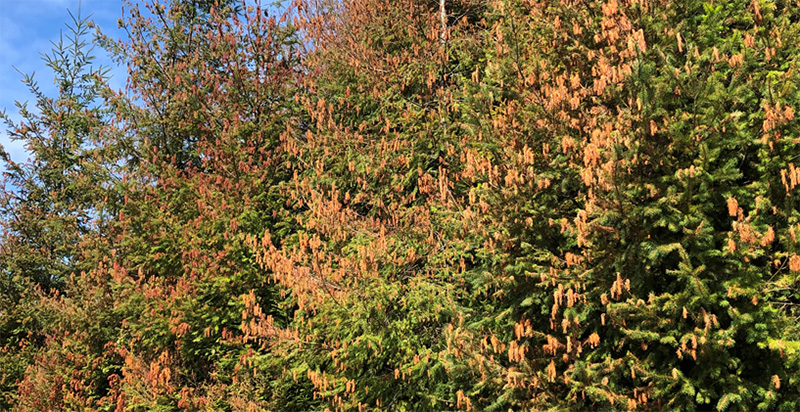
The U.S. Economic Development Administration (EDA) has awarded the Oregon Mass Timber Coalition (OMTC) $41.4 million to develop and expand Oregon’s emerging mass timber industry. The award was announced September 2, 2022, and addresses three significant issues across Oregon:
- A worsening housing crisis
- Increasing threats of wildfires
- The need to create good-paying jobs in communities recovering from the pandemic
The grant will support university research involving the use of mass timber in housing; spur development of a factory by the Port of Portland to produce mass timber housing; fund forest restoration projects in the Willamette National Forest; jump-start public-private partnerships to grow employment in the creation and use of mass timber in housing; and support efforts to modernize building codes in Oregon communities impacted by recent wildfires to enable recovery efforts using mass timber products in housing.
The EDA’s $1 billion Build Back Better Regional Challenge is a signature initiative of the Biden Administration’s American Rescue Plan program. It aims to boost economic recovery from the pandemic and rebuild American communities, including those grappling with decades of disinvestment. The OMTC is one of 21 coalitions selected from a nationwide pool of 529 applicants to receive funding through the EDA’s Build Back Better Regional Challenge.
“I’d like to thank the Biden-Harris Administration and the U.S. Economic Development Administration for recognizing the incredible work being done by the Oregon Mass Timber Coalition,” said Governor Kate Brown. “From the new roof for the Portland International Airport to housing materials, Oregon’s mass timber industry is at the cutting edge of sustainability and economic opportunity––helping to address the climate and housing crises while enhancing forest resiliency and creating jobs for people from rural communities, people with low incomes, and people of color.”
“This is a transformational moment for Oregon,” said Port of Portland Executive Director Curtis Robinhold. “The project will create rural and urban jobs with products grown and manufactured right here in Oregon. The innovations will enable production of high-quality building products from low-quality wood. This will increase housing, provide jobs and promote forest health. That means more homes at lower costs, new workforce opportunities and more climate-resilient communities. We are grateful to Oregon’s entire Congressional delegation for their support of the OMTC project and our vision for growing Oregon’s mass timber industry.”
The Oregon Mass Timber Coalition is a partnership between the Port of Portland, Business Oregon, Oregon Department of Forestry, the Department of Land Conservation and Development and the TallWood Design Institute (a collaboration between the University of Oregon and Oregon State University).
Mass timber is an advanced engineered wood product that is an alternative to the use of concrete and steel in multi-story buildings. “Already a global leader in mass timber, the Northwest is poised to bring mass timber forward as a housing solution,” said Iain Macdonald, director of the TallWood Design Institute. “Mass timber allows for rapid construction using sustainable, locally sourced, low-carbon wood products.”
President Biden visited Portland International Airport in April as part of a national infrastructure tour. He met with members of the OMTC and observed the use of locally sourced mass timber construction in PDX’s new nine-acre mass timber roof and learned how mass timber can be used in housing.
The $41.4 million federal investment will jump start development of mass timber housing products. The Port of Portland will use the funding for site improvements that will lead to constructing a factory at Terminal 2 in Northwest Portland to build mass timber housing.
“This award recognizes Oregon’s leadership in mass timber design, engineering and construction, supported by the TallWood Design Institute’s research and development work” said Judith Sheine, professor of architecture at University of Oregon. “The EDA grant will fund lab facilities and additional research and development critical to the continued growth of the mass timber sector and its expansion into the affordable housing market.”
The Build Back Better funding will support a comprehensive strategy for expanding the mass timber housing market, including:
- Mass timber research and innovation: The award will accelerate the mass timber research and development efforts by constructing an acoustic testing laboratory at University of Oregon and a fire testing facility at Oregon State University. In addition, the award advances applied research at UO and OSU by testing mass timber housing prototypes for structural, seismic, durability and energy performance.
- Terminal 2 Mass Timber Innovation Hub: Federal investment will offset the costs of site development for a mass timber modular home factory, the University of Oregon’s acoustics research lab and a fabrication facility at the Port of Portland’s Terminal 2. Planning for site improvements at T2 will begin immediately, with construction of the lab and site work expected to begin in 2024.
- Public-Private Partnerships will be developed to produce mass timber homes at a greater pace and promote workforce training opportunities in advanced manufacturing and the use of mass timber in construction.
- Sustainable sourcing: The Oregon Department of Forestry will receive funding to implement forest restoration projects within the Willamette National Forest to improve resilience, reduce wildfire risk, and provide a sustainable supply for mass timber production. Resilience treatments will utilize a materials track-and-trace program to provide utilization and resource accountability.
- Smart forestry initiative: OSU will receive funding for research and development to modernize forest restoration practices, including improved forest inventory mapping, enhanced forest worker health and safety, and efficiency within wood supply chain activities. OSU also will develop workforce training curriculum to help promote employment in the forest and wood products industry. “From forests to manufacturing to the construction site, we have designed a holistic suite of investments that create benefits across the supply chain,” said Iain Macdonald, Director of the TallWood Design Institute.
- Model development codes: The Department of Land Conservation and Development will modernize development codes to support the use of mass timber in newly built modular workforce housing in 10 communities, prioritizing those impacted by the 2020 wildfires. This will serve as a model for other communities looking to accelerate housing production using mass timber.
For more information about the Oregon Mass Timber Coalition, visit www.masstimbercoalition.org/projects.
For more information about the Port of Portland’s focus on mass timber, visit www.portofportland.com/masstimber.








